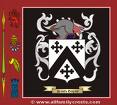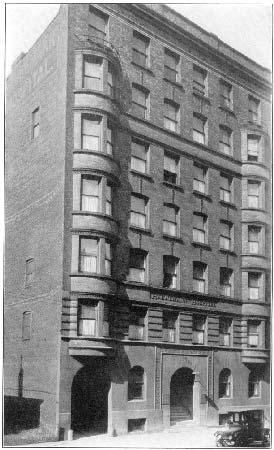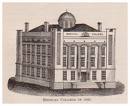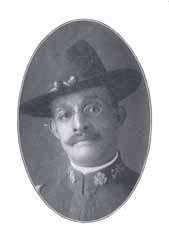The Anderson Surname and Homeopathy
March 01, 2008
 The Anderson surname
gave us several jobbing homeopaths, one famous homeopathic nurse (the
first registered nurse in New York State), a Professor of Pathology, a
hospital and college Dean and Professor of Obstetrics and Orthopaedic
Surgery, and an ex slave turned homeopath, chaplain of the Tenth United
States
Cavalry,
one of the first black
officers
to command an American military post, promoted to Major in 1907 and
commander of the United States Morgue.
The Anderson surname
gave us several jobbing homeopaths, one famous homeopathic nurse (the
first registered nurse in New York State), a Professor of Pathology, a
hospital and college Dean and Professor of Obstetrics and Orthopaedic
Surgery, and an ex slave turned homeopath, chaplain of the Tenth United
States
Cavalry,
one of the first black
officers
to command an American military post, promoted to Major in 1907 and
commander of the United States Morgue.
 Alfred
William Anderson
1879 -
Alfred
William Anderson
1879 -
of Lakewood, Ohio, born Erie, Pa., June 20, 1879 ; medical preceptor, Dr. John M. Davies of Warren, Pa. ; graduated M. D. from Cleveland Homœopathic Medical College, 1902 ; member of Lakewood board of health, 1903-1904 ; health officer, 1904.
 Bradley
Beecher Anderson
1841 -
Bradley
Beecher Anderson
1841 -
of Jackson, Michigan, born Calhoun county, Mich., November 16, 1841 ; literary education, Albion Wesleyan Seminary ; graduated, 1880, Hahnemann Medical College of Chicago.
 Bruce
Anderson 1874 -
Bruce
Anderson 1874 -
of Detroit, Michigan, was born in Montreal, Canada, August 12, 1874, son of James Donald and Mary Elizabeth (Frantz) Anderson. Among his ancestors were many medical practitioners.
He attended the Montreal preparatory and high schools, pursuing the associate and arts courses ; was a student in McGill University, 1890-1894, being graduated with a degree in comparative medicine.
He attended the Detroit Homœopathic College, graduating from that institution in 1901, and has since practiced in Detroit.
He is a member of the auxiliary medical staff of Grace Hospital ; is Professor of Pathology in Detroit Homœopathic College and associate clinician in pædology of the out-door clinic.
Dr. Anderson is a member of the Detroit Homœopathic Practitioners’ Society and of the Homœopathic Medical Society of the State of Michigan.
He married Janet McVittie of Detroit, December 1, 1898.
 Clarence Anderson was a
homeopath in Kentucky in
1911.
Clarence Anderson was a
homeopath in Kentucky in
1911.
 Herbert
Alexander Anderson
1858 -
Herbert
Alexander Anderson
1858 -
of Rochester, New York, born in the town of Riga, July 22, 1858 ; graduated M. D. from Hahnemann Medical College of Philadelphia in 1889.
 **Ida
Jane
Anderson**
1869-1958 New York State’s First Registered
Nurse trained at
the Rochester Homeopathic
Hospital.
**Ida
Jane
Anderson**
1869-1958 New York State’s First Registered
Nurse trained at
the Rochester Homeopathic
Hospital.
Oh, the graduates of 1902 We’re the kind That were always true blue Their work never shirking, With no interne’s flirting, Those nurses of 1902.
This class poem was composed in 1903 by Ida Jane Anderson while she was a student at the Rochester Homeopathic Hospital (later The Genesee Hospital) class of 1902.
Ida Jane was a remarkable woman, with a nursing career spanning several decades. Most notably, she was the first registered nurse in New York State, receiving this distinction after the passage of the Nurse Registration Act in 1903.
Born January 12, 1869 in Napanee, Ontario, Canada Ida Jane spent her early years with her father, J. Luman Anderson, a shoemaker, and her mother Anna Eliza Mills Anderson, along with three brothers and three sisters.
In July 1887, at the age of 18, she left Canada alone and came to the port of Charlotte, New York. Ida Jane settled in the city of Rochester, New York becoming a dressmaker. Her brother, Charles, followed three years later and went on to build a successful business manufacturing soft-soled baby shoes.
In June 1899, at the age of 30, she enrolled in the Rochester Homeopathic Hospital Nurses’ Training School. Living in the nurse’s residence on Alexander Street, she studied and worked long hours. She enjoyed her three years in nurses’ training as evidenced by her association with the alumni organization, the writing of the class poem, the class yell and class song.
After her graduation in 1902, her parents relocated to Rochester, living at 179 Henrietta Street with Ida Jane and their six-month-old granddaughter, Ila Anderson. Ida Jane, who never married, essentially stepped into motherhood and raised her niece, whose mother had died in 1903.
In the 1930’s, Ida Jane became a world traveler. When home in Rochester, she preferred to travel on foot and was an avid walker. She was also expert in crocheting and knitting.
Ida Jane Anderson spent much of her career in private practice. She was the first graduate nurse to become a night supervisor at the Rochester Homeopathic Hospital. Later she became the hospital’s second Social Worker in 1909. She also worked at Strong Memorial Hospital in the 1940s.
During the Smallpox Epidemic of 1902 she nursed the victims at Hope Hospital. Throughout he career she remained active with the Alumni Association holding several offices.
Ida Jane died at Monroe Community Hospital in 1958 and is buried at Mt. Hope.
She donated her uniforms along with her hospital pins and other memorabilia to the Alumni Archives.
Ida was honoured with a plaque at Rochester Hospital on 2.10.2004
 Jefferson
Charles Anderson
1867 -
Jefferson
Charles Anderson
1867 -
He attended the public schools of Monticello, Florida, and Wayland Seminary at Washington, D. C., and was graduated A. B. from Lincoln University in June, 1894.
He matriculated at the New York Homœopathic Medical College and Hospital in October, 1895, and was graduated from that institution in May, 1899, and since February, 1900, has practiced in Plainfield, New Jersey.
Dr. Anderson is a member of the New Jersey State Homœopathic Medical Society.
He married, July 19, 1899, Mary Fossett, and has one child, Zenaide Anderson.
 Matthew Anderson
was a prominent Philadelphian homeopath in
1840.
Matthew Anderson
was a prominent Philadelphian homeopath in
1840.
 Samuel
Hahnemann Anderson
1850 -
Samuel
Hahnemann Anderson
1850 -
of Kansas City, Missouri, was born in Greenfield, Ohio, July 8, 1850, a son of Samuel Brooks Anderson, M. D., a graduate of the Eclectic Medical College, Cincinnati, Ohio, who settled in Lawrence, Kansas, in 1868, and was one of the pioneers of homœopathy in Kansas, while at the present time he is practicing in Denver, Colorado.
He married Nancy L. Davis, daughter of the late Dr. Jeptha Davis, a sister of Dr. Jeptha Davis, of Ottawa, Kansas, and granddaughter of Dr. Paxton, who was a medical practitioner of Washington Court House, Ohio.
Dr. Anderson, after attending the Greenfield (Ohio) Seminary, studied in the State University at Lawrence, Kansas, and began reading medicine with his father. After two years’ study he was graduated M. D., in 1876, from the Homœopathic Medical College of Missouri.
He practiced in Lawrence, Kansas, from 1876 until 1881, and since that time in Kansas City. He has done post-graduate work in the Kansas City Homœopathic Medical College at various times, and in 1876 pursued a special course in obstetrics in St. Louis, Missouri.
He was surgeon for the Kansas City, Osceola & Southern Railroad Company at the Fort Scott, Memphis & Gulf Railroad Hospital ; on the staff of the Kansas City Homœopathic Hospital ; Dean of the Kansas City Homœopathic Medical College, and is the first Dean of the Kansas City Hahnemann Medical College and its Professor of Obstetrics and Orthopedic Surgery.
Dr. Anderson formerly was a member and secretary of the Homœopathic Medical Society of Kansas and a member of the board of examiners ; created by the legislature. He is a member of the Western Academy of Homœopathy and the Missouri State Homœopathic Medical Society.
He married Julia Hostetter, September 18, 1880.
 William Thomas
Anderson
1859-1934
William Thomas
Anderson
1859-1934
clergyman and physician, was born a slave in Seguin, Texas, on August 20, 1859.
During the Civil War he and his mother moved to Galveston, where he joined the African Methodist Episcopal Church. The congregation sponsored him at Wilberforce University in Ohio for three years, and he received a theology certificate from Howard University in 1886.
In 1888 he graduated from the Homeopathic Medical College of Cleveland.
Anderson then pastored congregations in Toledo, Urbana, Lima, and Cleveland, Ohio. In 1897 homeopathic supporter President William McKinley appointed Anderson chaplain of the Tenth United States Cavalry, with the rank of captain.
In April 1898 the regiment departed for the Chickamauga area from its headquarters at Fort Assinniboine, Montana. Anderson remained behind and is believed to be one of the first black officers to command an American military post.
On July 24, 1898, he joined the Tenth near Santiago, Cuba, where he treated the sick for fever and dysentery.
After the war he coedited Under Fire with the Tenth Cavalry (1899, 1969), a book about the heroism of black soldiers in the war based on eyewitness accounts.
From mid-1899 to 1902 the regiment occupied Manzanillo, Cuba. In Cuba and later in Nebraska, Anderson helped enlisted men organize a regimental YMCA as a means to engage in self-help, address issues of concern, and discuss racial matters.
In April 1907 he and the regiment were sent to Fort William McKinley, near Manila, Philippines. Anderson was promoted to major in August 1907 and commanded the United States Morgue.
On January 10, 1910, he retired because of a disability caused by a fever contracted in Cuba in 1898. He returned to Wilberforce and worked as an accountant and secretary to the bishop in the Third Episcopal District.
Anderson died in Cleveland on August 21, 1934. He was survived by his wife Sada J. Anderson, who was also active in the AME church. An American Legion post was named for him in the Cleveland area.
Rev. W. T. Anderson was born in Texas, August 20, 1859, and started his collegiate work at Wilberforce University, in Ohio, going later to Howard University, at Washington, D. C., where he won a diploma, to which he added another from the Homeopathic Hospital College, at Cleveland, Ohio.
His finely-trained mental powers, magnetic individuality and zeal in his work brought him desirable Pastorates in Ohio and Mississippi, and excellent results have attended his Ministerial labors.
In 1897 he received the appointment of Chaplain to the Tenth Cavalry, which position he still holds. Rev. Anderson is a Permanent Trustee of Wilberforce University, and was a Delegate to the last General Conference at Chicago.